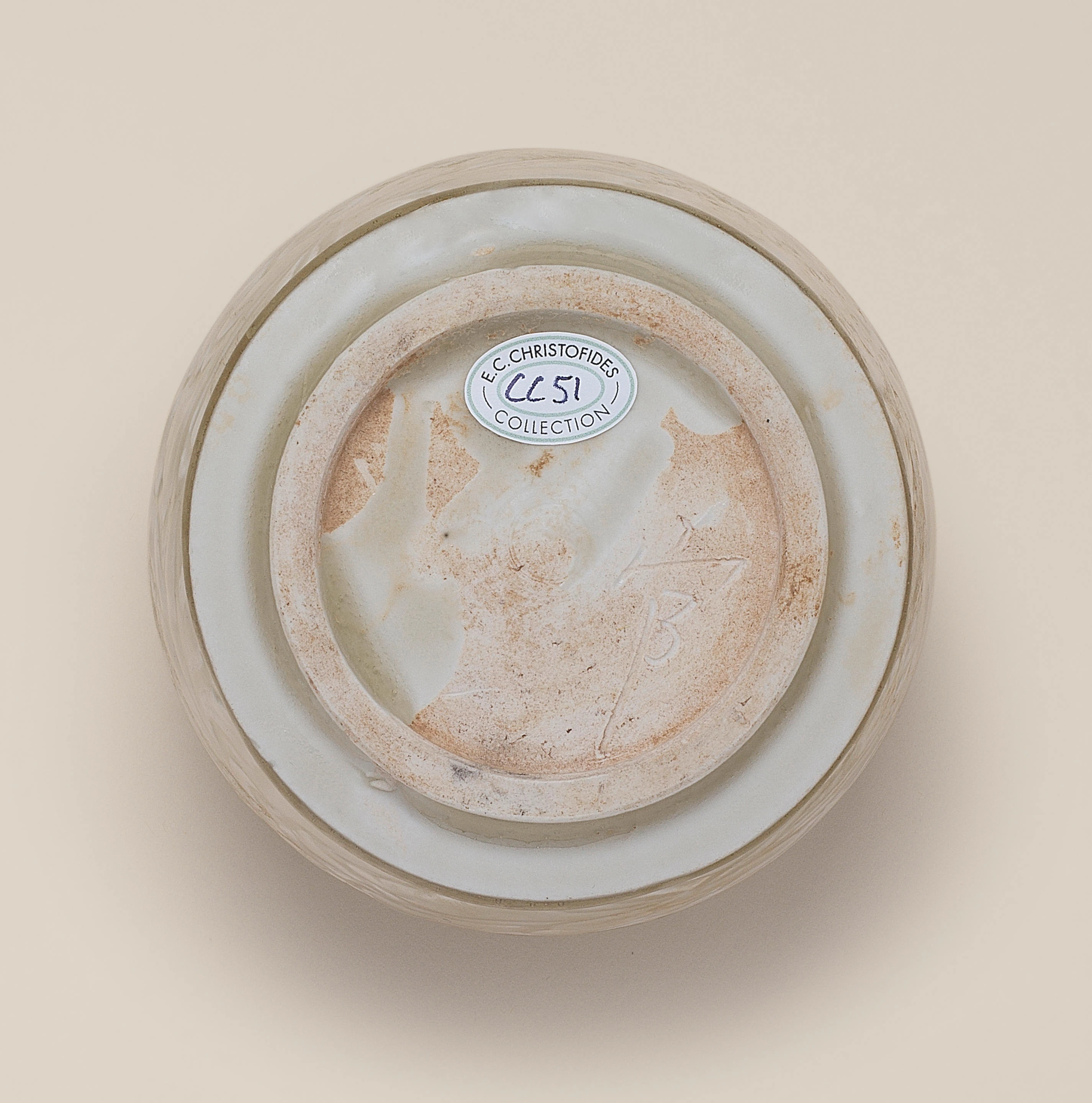宋代筆記 vol.135 東京國立美術館:五代北宋定窯白瓷划花花瓣紋小圓壺,「新官」刻款 - TNM, Ding Ware Incised Globular Jar with ‘New Official’ Marks, Five Dynasties to Northern Song Dynasty
- SACA

- Jul 2
- 6 min read

「新官」款定瓷代表了唐末五代定窯白瓷製作的頂峰,是早期中國官用瓷器制度化、標準化的物證。其與「官」字款並存但用途略有差異,反映出當時宮廷或地方政權對於瓷器品質、制度與用途的高度重視。「新官」款瓷器作為極為罕見的遺存,具有極高的藝術價值、歷史價值與學術研究意義。
The "Xinguan" (New Official) marked Ding ware represents the pinnacle of white porcelain production at the Ding kilns during the late Tang and Five Dynasties period. It serves as material evidence of the early institutionalization and standardization of official-use ceramics in China. Coexisting with the more common "Guan" (Official) marked wares but likely serving distinct purposes, the "Xinguan" pieces reflect the high level of attention paid by the court or regional authorities to the quality, regulation, and function of ceramic vessels. As exceptionally rare surviving artifacts, "Xinguan" marked wares possess outstanding artistic, historical, and scholarly value.

定窯白瓷划花花瓣紋小圓壺
「新官」銘
五代 - 北宋
高6.6 口径3.5 高台径4.3
東京國立博物館
横河民輔氏寄贈
機構管理序號:TG-1375

關於官、新官,參考SACA學會發表的文章:《展覽筆記 vol.2 唐五代定窯「官」款 西安火燒壁窖藏,西安博物館 - Ding Ware 'Official' and 'New Official' Marks, Tang to Five Dynasties Found at 'Huoshaobi', Xi'an Museum》
新官款:
官字款:
何謂「新官」?
根據西安火燒壁窖藏白瓷的考古資料與相關紀年墓出土器物的比對研究,我們可以對「新官」款定窯白瓷提取出以下更為詳細的內容與理解:
一、「新官」款的首次出土與斷代
「新官」款白瓷首次於**浙江臨安晚唐時期錢寬墓(唐光化三年,公元900年)出土,該墓共出土15件定窯白瓷,其中13件刻有「官」字款,1件刻「新官」款。緊接著其夫人水邱氏墓(卒於901年)**中又出土17件白瓷,其中有3件刻「官」款、11件刻「新官」款,其數量之多,說明「新官」款並非偶發,而是一批有計劃地燒製供應的官府用器。
這些「新官」款器物的斷代極為清晰,具有很強的學術價值,是目前已知最早可明確斷代的“新官”款瓷器,其出土時間標誌着「新官」款的燒製與使用至少可追溯至公元900年前後(唐末)。

二、「新官」器物的造型與風格特徵
錢寬夫婦墓中所出「新官」款瓷器以花口盤與葵口碗為主,其器形多仿自唐代宮廷金銀器,如三瓣花口盤、五瓣花口碗、折沿葵口盤等,形式華美,做工細膩,造型纖巧,充分體現宮廷美學。
這些器物胎體極為薄細,胎白細膩不施化妝土,釉層瑩潤均勻,色澤白中閃青。釉面在燒造過程中因流動而形成「淚痕」現象,是早期定窯白瓷的一大特徵。
其刻款位置多位於器底中心,「新官」兩字多為行楷體,刀法流暢,筆意秀勁,顯示當時匠人的書法與刀工水準都極高。部分器物還裝有金屬扣邊(如銀邊),反映其作為高等用器或供佛器的地位。

三、「新官」與「官」字款的關係
「新官」款器物與「官」字款器物在胎釉、造型與製作技術上幾乎無異,應屬於同一批次或同一窯口的產品。然而從墓葬出土的數量與搭配來看,「新官」款可能是針對某一特定政策或朝廷需求(如改制、重設某機構、或新皇登基)所燒造的器物,用以區別「舊制」的「官」款瓷器。
部分學者推測,「新官」可能代表「新設官樣」、「新制官樣」的省寫,具有制度更新與標準樣品的含義,亦即這些瓷器作為官方認可的標準器,用以指導或驗收徵收品。

四、產地與窯口問題
雖然「新官」款瓷器最初出土於浙江臨安,但當地並未發現晚唐五代時期能生產如此精細白瓷的窯址。根據胎釉比對、技術分析與歷史記載,學界一致認為這些瓷器來自於河北曲陽的定窯系統。定窯於唐代晚期已能燒製高品質白瓷,並開始承擔官府供應任務。
定窯早期燒造方法為一匣一器的正燒法,器物口沿不接觸匣鉢,可施滿釉,底部以石英砂墊隔避免黏連,這與錢寬、水邱氏墓與火燒壁窖藏中的「官」「新官」款白瓷製作方式完全一致。

五、「新官」款的歷史與制度意義
綜合各地考古出土資料來看,「新官」款瓷器的流行時間集中在晚唐至五代,北宋以後逐漸被「官」款取代。這一現象反映出唐末五代政局動盪,各地藩鎮與朝廷需要以制度化方式標識、監管器物供應與使用,「新官」款即是這一背景下的產物。
此外,「新官」款瓷器大量出現在與皇親貴胄有關的墓葬中,如吳越王父錢寬、遼王墓等,並曾用作佛寺供奉(如可能供奉於長安千福寺),證明它在當時屬於宮廷、宗教與高級官府使用的最高級別瓷器。

小結
「新官」款定瓷代表了唐末五代定窯白瓷製作的頂峰,是早期中國官用瓷器制度化、標準化的物證。其與「官」字款並存但用途略有差異,反映出當時宮廷或地方政權對於瓷器品質、制度與用途的高度重視。「新官」款瓷器作為極為罕見的遺存,具有極高的藝術價值、歷史價值與學術研究意義。
白磁劃花花弁文小円壺
名称よみ:はくじかくかかべんもんしょうえんこ
員数:1口
作者:中国・定窯
時代世紀:北宋時代・10世紀
品質形状:磁器
法量:高6.6 口径3.5 高台径4.3
銘文等:「新官」銘
寄贈者:横河民輔氏寄贈
所蔵者:東京国立博物館
機関管理番号:TG-1375
分類:東洋陶磁

Small Globular Jar White porcelain with incised flower petal design
Category:
Cultural property designation:
Quantity:
Artist: Ding ware, China
Period/Century: Northern Song dynasty, 10th century
Country/Origin:
Excavation site:
Material:
Size:
Inscriptions: 「新官」銘
Donor: Gift of Dr. Yokogawa Tamisuke
Holder: Tokyo National Museum
Collection reference no.: TG-1375
Genre: Asian Ceramics
Summary of Xi’an Museum’s Huoshaobi Cache of “官”-Marked Tang White Porcelain
In March 1985, a construction crew north of Xi’an West Railway Station unearthed a buried grey pottery jar at a depth of 0.6 m containing over 100 ceramic fragments. Archaeologists recovered 52 largely intact pieces—33 of which bear the carved character “官” (guan, “official”) on the glaze, while 17 are unmarked. Three marked pieces were sent to the Shaanxi History Museum; the remainder are now in the Xi’an Museum.
“官”-marked Wares (33 pieces)These fine white-glazed porcelain items fall into six shapes:
Three-lobed flower-rim plates (17 pieces, Ø 11.7 cm)
Five double-ridge petals plates (Ø 14.4 cm)
Five pointed-petal plates (Ø 13.5 cm)
Five broad-petal plates (Ø 13.6 cm)
Five broad-petal shallow bowls (4 pieces, Ø 13.8–21 cm)
Straight-rim bowls (Ø 16.8 cm)
All are wheel-thrown with exceptionally thin, delicate bodies and an even, snowy-white glaze tinged pale blue. The “官” inscription was incised into the glaze before firing.
Unmarked Wares (17 pieces)These include everted flower-rim plates, round rim plates, curved-wall plates, and ring-foot bowls. They share the same kiln characteristics—fine white body, uniform glaze, occasional “teardrop” drips—but display slightly coarser execution.
Kiln Attribution and DatingStylistic and archaeological evidence attribute both the marked and unmarked pieces to the early Ding kiln (Quyang, Hebei) during the late Tang–Five Dynasties period (c. 900–930 CE). Similar “官”‐marked wares appear in contemporary tombs of high-ranking figures (e.g., the 900 CE Qian Kuan tomb in Lin’an), confirming a production date around the turn of the 10th century.
Function and Significance of the “官” MarkRather than denoting a state-run “official kiln,” the “官” mark likely signified government-commissioned luxury porcelain meeting a mandated quality standard—used by imperial relatives, aristocrats, and in major Buddhist temples. The high craftsmanship, varied flower-rim forms, and occasional gold or silver mountings underscore their ceremonial or courtly role.
Burial ContextThe cache was interred at the site of Tang-period Qianfu Temple (est. 673 CE) in Chang’an’s An Ding Fang district, probably hidden during the city’s turmoil in the early 10th century. Rediscovered in 1985, these rare wares provide invaluable insight into late Tang official patronage of Ding kiln porcelain.




























Comments